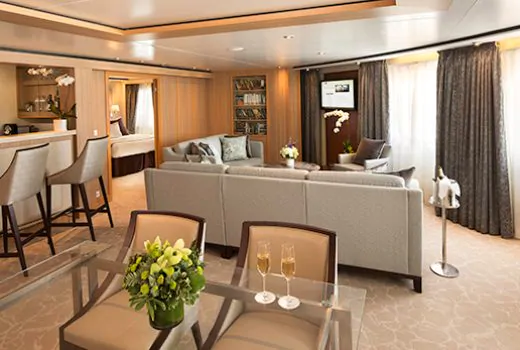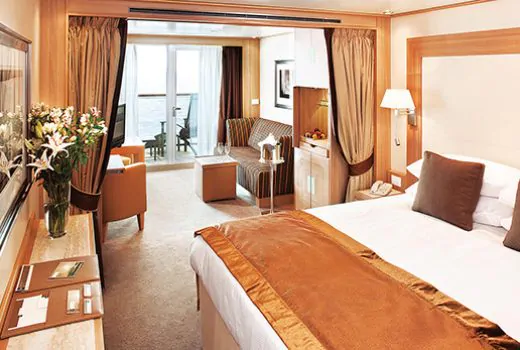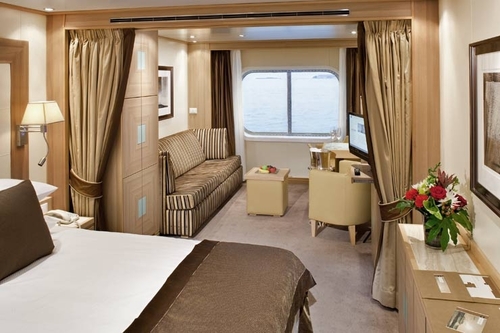West African Discovery: Cape Town To The Canaries
- 28 Jan ‘25
- 22 nights
- Departing from Cape Town
- Seabourn Sojourn
-
Inside price fromCall for price
-
Outside price from$13,499*/pp
-
Balcony price from$15,999*/pp
-
Suite price from$20,799*/pp
YOUR ITINERARY
Cape Town, South Africa - Cape Town, South Africa - Luderitz, Namibia - Walvis Bay, Namibia - Walvis Bay, Namibia - Crossing the Equator - Cotonou - Lome - Banjul, Gambia - Dakar, Senegal - Las Palmas, Spain
Nestled at the foot of Table Mountain and flanked by DevilR...
Nestled at the foot of Table Mountain and flanked by Devil’s Peak and Lion’s Head, Cape Town is known by South Africans simply as ‘the Cape,’ an acknowledgment of its uniqueness and its status as the Mother City. The first area to be settled by Europeans in the 17th century, it is today a major seaport and the legislative capital of South Africa. The feeling here is not African but cosmopolitan, and a sense of history remains.
Nestled at the foot of Table Mountain and flanked...
Nestled at the foot of Table Mountain and flanked by Devil’s Peak and Lion’s Head, Cape Town is known by South Africans simply as ‘the Cape,’ an acknowledgment of its uniqueness and its status as the Mother City. The first area to be settled by Europeans in the 17th century, it is today a major seaport and the legislative capital of South Africa. The feeling here is not African but cosmopolitan, and a sense of history remains.
In 1883, a German businessman, Adolf Luderitz, purch...
In 1883, a German businessman, Adolf Luderitz, purchased a parcel of land enclosing a small bay for purposes of speculation. The so-called Skeleton Coast had limited potential in many ways, being largely made up of the shifting sands of the Namib Desert. Then, in 1906, a local railway worker noticed an oddly sparkly stone beside the tracks. It proved to be a diamond, and it became clear that there were many like it lying literally on the surface of the sands. By 1909 a diamond rush was in full sway, and a thriving, German-styled town called Kolmanskop sprouted out of the desert to house the gem-seekers. When the easy pickings ended, the townspeople simply walked away, and the desert climate preserved the town as it was slowly engulfed by the shifting sands. Today it makes an evocative and haunting place to visit. The bay still hosts a bounty of wildlife as well, including seals, whales and flamingos. Other endeavors have started, too, such as the culture of delicious oysters in the clean, cold ocean waters.
Its name in Afrikaans means “Whale Bay,” but those...
Its name in Afrikaans means “Whale Bay,” but those days are long gone. Today its dramatic setting is inseparable from any impression of this deep-water port on Namibia’s desolate, but beautiful “Skeleton Coast.” Here the undulating dunes of the Namib Desert meet the sea, and its lagoon is spangled with white pelicans, pink flamingos and other seabirds. Up the coast road is Dune Seven, the highest along Namibia’s coast, and a great place to take off your shoes and feel some sand between your toes after your Atlantic crossing.
Its name in Afrikaans means “Whale Bay,” but th...
Its name in Afrikaans means “Whale Bay,” but those days are long gone. Today its dramatic setting is inseparable from any impression of this deep-water port on Namibia’s desolate, but beautiful “Skeleton Coast.” Here the undulating dunes of the Namib Desert meet the sea, and its lagoon is spangled with white pelicans, pink flamingos and other seabirds. Up the coast road is Dune Seven, the highest along Namibia’s coast, and a great place to take off your shoes and feel some sand between your toes after your Atlantic crossing.
If you are a “pollywog,” who has never crossed the lin...
If you are a “pollywog,” who has never crossed the line at sea, you will be expected to undergo a mock trial by King Neptune and his court for the entertainment of the “shellbacks” who have already done so. Mild but hilarious indignities will be conjured, and in the end a good time will be had by most, if not all.
Cotonou is a large port city on the south coast of Benin, in W...
Cotonou is a large port city on the south coast of Benin, in West Africa. At the eastern end of central Boulevard St. Michel is the huge Dantokpa Market, which features religious items and spices alongside everyday objects. To the southwest, the 19th-century Cotonou Cathedral has a striking red-and-white striped facade. Nearby, in the Haie Vive district, the Fondation Zinsou museum shows contemporary African art.
Like much of West Africa, Togo is a result of European co...
Like much of West Africa, Togo is a result of European colonial disruption of long-standing African kingdoms. Togo’s long, thin territory reflects its history as a trade franchise for Germany, which controlled the coastline and plundered the interior. The country’s citizenry is made up of 40 ethnic groups. Blessed with broad golden beaches and a sunny, warm climate, Togo is a favorite of European vacationers. The huge Grand Market distributes everything required for life in the city. The picturesque and fragrant Akodessewa fetish market dispenses all sorts of botanicals and mummified animal parts to the 51 percent of Togo’s population who are practitioners of Vodun or other native animist religions. It is the largest such market in Africa and draws devotees from all over the continent. The smaller Centre Artisanal offers handcrafts. The National Museum is a good place to learn more about the history and cultures of Togo, with displays of traditional jewelry, clothing, pottery, sculpture and musical instruments. Modernist monuments around town include the Independence Memorial and the Peace Dove Monument, while the tall steeples of the red-and-white Cathedral are a memorial of German colonial occupation. The city’s pace is slower and more relaxed than other West African capitals, and the golden sands of Lomé and Aneho beaches invite you to admire the rolling sapphire surf from the Gulf of Guinea.
The Gambia takes its name from the river that runs through ...
The Gambia takes its name from the river that runs through it. In fact the nation consists largely of the river and a narrow band of riparian land on either side of it. The smallest nation on the African mainland, it is only 30 miles wide at its broadest point, and surrounded on three sides by Senegal. The capital of Banjul, formerly known as Bathurst, slumbers on small St. Mary’s Island near the river’s mouth. The town’s life centers around the bustling Albert Market, where nearly everything is traded in any (or several) of the country’s five official languages, plus French and English. The National Museum is a good place to get a look at the historic and ethnographic makeup. South of the town is Abuko Nature Reserve, a 180-acre section of savannah forest preserved in 1968 through the efforts of the country’s first forest officer, Eddie Brewer. The reserve is a good place to see examples of the native fauna including several species of monkeys, hyenas, antelope, and reptiles including crocodiles and monitor lizards. It also attracts more than 270 species of birds.
One of the most vibrant and cosmopolitan African ci...
One of the most vibrant and cosmopolitan African cities, the Senegalese capital bears many visual reminders of its past as a French colonial outpost. Despite the Parisian-style boulevards and buildings, however, there is a distinctly African feel to the city. Bankers and executives can be seen going about their businesses dressed in the flamboyant traditional Grand Boubou costume, and women wear the feminine version with an equally striking headpiece. The common language is French, although many citizens may also speak as many as five or six ethnic languages, since the whole coast of West Africa has been steeped in a heritage of mutual trade for centuries. Among the many sights and sounds greeting visitors, none is more evocative and sobering than a visit to Goree Island and its House of Slaves. This fortress, just offshore of the city waterfront, displays many reminders of the brutal trade in human beings, including an unimposing doorway, set just above the waterline in the seaside wall, identified simply as the “Door of No Return.”
Las Palmas is a large Spanish city, which just happens to be ...
Las Palmas is a large Spanish city, which just happens to be on the island of Gran Canaria. That fact adds the exotic, slightly African and international flavor to the place. It played an important part in the early exploration and exploitation of Africa and the New World, some of which is recounted in the Casa de Colon Museum. Columbus may have slept there, but it was never his house. It was actually the mansion of early governors. Other museums of note are the Museo Canaria with a number of Cro Magnon skulls, and the fascinating Elder Museum of Science and Technology. For shopping, strolling and general local interest, head to La Vegueta, the oldest quarter and a UNESCO World Heritage Site, and the adjacent Triana high street shopping district. Most visitors are here for the beaches, and the municipal Playa de Las Canteras is a long, clean and safe option if that is your intention. The Canaria in the name of the islands refers to the indigenous Presa Canaria breed of dogs, which are large, strong and made quite an impression on the earliest Spanish visitors.
YOUR SHIP - The Seabourn Sojourn
Seabourn Sojourn enchants her guests with an array of public areas scaled to encourage a relaxed sociability. One of the most unusual features of Seabourn Sojourn and her sisters is Seabourn Square, an ingenious “living room” that replaces the traditional cruise ship lobby with a welcoming lounge filled with easy chairs, sofas and cocktail tables; making it more inviting and relaxing on a small ship cruise. An enclave in its center houses knowledgeable concierges discreetly seated at individual desks.
Seabourn Sojourn enchants her guests with an array of public areas scaled to encourage a relaxed sociability. One of the most unusual features of Seabourn Sojourn and her sisters is Seabourn Square, an ingenious “living room” that replaces the traditional cruise ship lobby with a welcoming lounge filled with easy chairs, sofas and cocktail tables; making it more inviting and relaxing on a small ship cruise. An enclave in its center houses knowledgeable concierges discreetly seated at individual desks.
Beauty Salon
Facial Treatments
Massage
Sauna
Spa
Swimming Pool
Thalassotherapy Pool
Whirlpool
In-Suite Service
Patio Grill
Sky Bar
The Colonnade
The Restaurant
The Restaurant 2
Gym
Sports Deck
Description
Seabourn Sojourn enchants her guests with an array of public areas scaled to encourage a relaxed sociability. One of the most unusual features of Seabourn Sojourn and her sisters is Seabourn Square, an ingenious “living room” that replaces the traditional cruise ship lobby with a welcoming lounge filled with easy chairs, sofas and cocktail tables; making it more inviting and relaxing on a small ship cruise. An enclave in its center houses knowledgeable concierges discreetly seated at individual desks.
Relaxation
Beauty Salon
Facial Treatments
Massage
Sauna
Spa
Swimming Pool
Thalassotherapy Pool
Whirlpool
Food and Drink
In-Suite Service
Patio Grill
Sky Bar
The Colonnade
The Restaurant
The Restaurant 2
Fitness
Gym
Sports Deck
STATEROOMS

suite

balcony


